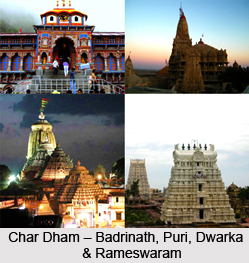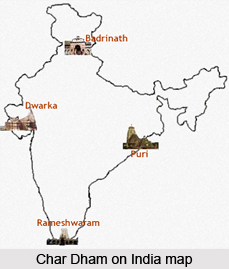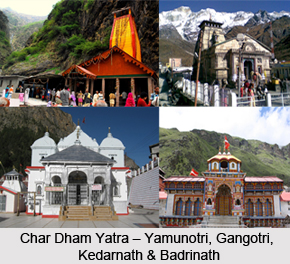 "Char Dham", meaning four abodes, refer to the four pilgrimage destinations in India that are considered most sacred by the Hindus. These four pilgrimage sites spread across all directions in the country are - Badrinath in the northern state of Uttarakhand, Puri in the eastern state of Odisha, Dwarka in the western state of Gujarat and Rameswaram in the southern state of Tamil Nadu. These sites are believed to be the four holy abodes of Hindu Gods, and thus regarded as most sacred by the Hindus, to be visited during one"s lifetime.
"Char Dham", meaning four abodes, refer to the four pilgrimage destinations in India that are considered most sacred by the Hindus. These four pilgrimage sites spread across all directions in the country are - Badrinath in the northern state of Uttarakhand, Puri in the eastern state of Odisha, Dwarka in the western state of Gujarat and Rameswaram in the southern state of Tamil Nadu. These sites are believed to be the four holy abodes of Hindu Gods, and thus regarded as most sacred by the Hindus, to be visited during one"s lifetime.
The aforementioned Char Dham is the bigger circuit Char Dham spread across the country in all directions, and is not to be confused with the smaller circuit Char Dham, which are the four holiest Hindu pilgrimage sites within the mountainous state of Uttarakhand.
The bigger circuit of Char Dham was defined by Adi Shankaracharya during the 8th century. Out of the total four pilgrimage places, Badrinath, Dwarka and Puri are Vaishnavite sites, in foremost veneration to Lord Vishnu and Rameswaram is a Shaivite site, in foremost veneration to Lord Shiva. This Char Dham is also referred to as the "Char Dham of India" and "Char Dham of Adi Shankaracharya".
The smaller circuit of Char Dham is known as "Chota Char Dham", encompassing the four holiest sites of Yamunotri, Gangotri, Badrinath and Kedarnath, all situated in the Garhwal Himalayan region of Uttarakhand. Adi Shankaracharya attained freedom from embodiment in the Garhwal Himalayas. Since 1960s, this Char Dham network has evolved in terms of importance and reverence, and came to be also referred to as the "Char Dham". They are also referred to as the "Char Dham of Himalaya" and "Char Dham of Uttarakhand". It is these four pilgrimages together that form the network of the famous Char Dham Yatra, which is a premier pilgrimage journey for the Hindus, to be undertaken at least once in the lifetime.
Pilgrimage Sites of Char Dham, Hindu Pilgrimage
The four holy destinations forming the Char Dham - Badrinath, Dwarka, Puri and Rameswaram, geographically form a square of India"s map, with Badrinath and Rameswaram along the same longitude, in the north and south respectively, and Puri and Dwarka along the same latitude, in the east and west of the country respectively.
Badrinath, Char Dham
Badrinath is situated in the North Indian state of Uttarakhand, in the Garhwal region of Himalaya Mountains, on the banks of the Alaknanda River. The town, lying under the Nilkantha peak (elevation 6,560 metres), came to be known as the first Dham when it gained religious prominence in the Sat-Yuga. Badrinath is in foremost devotion to Lord Vishnu.
Puri, Char Dham
Puri is a holy city in the eastern state of Odisha. It is one of the oldest cities in the eastern part of the country, situated along the Bay of Bengal coast. The main deity worshipped in this sacred site is Lord Krishna, celebrated as Jagannath. Lord Krishna is an incarnation of Lord Vishnu. It is the only shrine in India where Goddess Subhadra, sister of Lord Krishna, is worshipped along with her brothers, Jagannatha and Balabhadra. The main shrine, Jagannath Temple, is about a thousand years old. Puri is also the site of Govardhana Matha, one of the four "mathas" or cardinal institutions established by Adi Shankaracharya. It is the place where the Oriya people enthusiastically celebrate the Ratha Yatra festival.
Dwarka, Char Dham
Lying in the westernmost part of India, the city of Dwarka is situated in the Gujarat state. It gained its significance when Lord Krishna made Dwarka his dwelling place, instead of Mathura, his birthplace. The Dwarakadheesh Temple is the main Hindu temple, devoted to Krishna. Its main shrine, Jagat Mandir, is supported by 72 pillars and is believed to be around 2000 years old as per archaeological findings.
 Rameswaram, Char Dham
Rameswaram, Char Dham
The town of Rameswaram is located in the South Indian state of Tamil Nadu, in the Gulf of Mannar at the very tip of the Indian peninsula. It became religiously prominent in the Treta-Yug when Lord Rama built a Shiva Linga here, and worshipped it seeking the blessings of Lord Shiva. Legend also has that Rama built a bridge "Rama Setu" in the town, connecting to Lanka. The Ramanathaswamy Temple is the main shrine dedicated to Lord Shiva, occupying a major area of Rameswaram. The deity worshipped is in the form of a Linga. The town is also significant for Hindus as a pilgrimage to Benaras (Varanasi) is incomplete without a pilgrimage to Rameswaram.
Char Dham Yatra, Char Dham
The Char Dham Yatra covers the holiest sites in the Garhwal Himalayas of Uttarakhand, access to which is from Haridwar, Rishikesh or Dehradun, in the state. The tradition of completing this pilgrimage is in the given order:
•Yamunotri, the source of the Yamuna River and the abode of the Goddess Yamuna.
•Gangotri, the source of the Ganga River and abode of the Goddess Ganga.
•Kedarnath, where Hindu God Shiva is venerated as one of the 12 Jyotirlingas (12 holiest shrines of Shiva).
•Badrinath, the abode of Hindu God Vishnu in his aspect of Badrinarayan.
The annual Char Dham Yatra restarted in May 2014 after remaining suspended since the outbreak of 2013 Uttarakhand Floods. The footfall has increased since then with proactive measures taken up by the Uttarakhand government. Millions of Hindu devotees complete the Char Dham Yatra and pay worship in the temples every year, also believing it to wash away all sins and open doors to Moksha. Beside the spirituality facet, the Char Dham pilgrimage sites and the Char Dham Yatra offer the best of nature"s sightseeing.



















